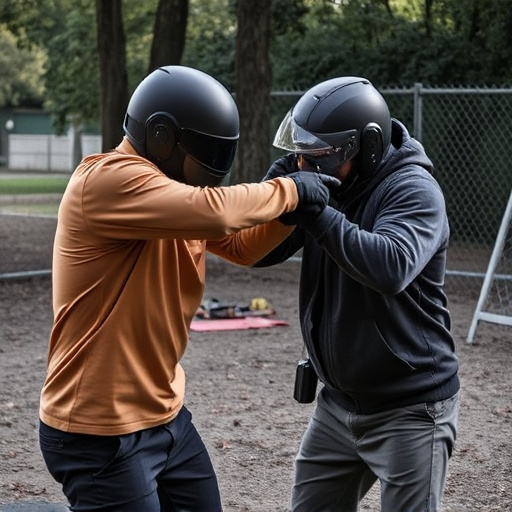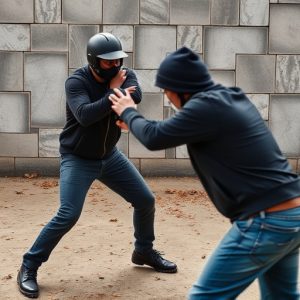Unlocking Stun Gun Performance: A Buyer’s Guide to Stopping Power
When choosing a stun gun for self-defense, focus on high joule ratings (50,000-100,000) indicating p…….
When choosing a stun gun for self-defense, focus on high joule ratings (50,000-100,000) indicating power. Key features include multiple contact points, ease of use, and reputable brands with detailed information on stop time, shocks per charge, and reliability. Evaluate voltage, current output, and electrode configuration—wider electrodes with DC current deliver stronger pulses for better effectiveness. Understand varying testing methods behind stopping power ratings to ensure accurate performance evaluations. Decipher product labels with specifications like voltage, amperage, and certified testing standards from reputable labs. Prioritize safety and effectiveness by selecting models meeting industry standards, with high voltage (50,000-120,000 volts) and reliable trigger mechanisms, while ensuring compliance with local laws.
“Uncover the truth behind stun gun stopping power ratings—a crucial guide for anyone considering self-defense. Understanding these ratings is essential when evaluating the effectiveness of a stun device. From testing methods and key performance indicators to safety best practices, this article demystifies what to look for when buying stun guns. Learn how various factors influence their rated performance and gain insights into interpreting labels accurately. Stay informed and make an empowered decision for your personal safety.”
- Understanding Stun Gun Stopping Power Ratings
- Key Factors to Consider When Evaluating Stopping Power
- How Testing Methods Influence Rated Performance
- Reading and Interpreting Stun Gun Labeling
- Ensuring Safety and Effectiveness: Best Practices for Purchase
Understanding Stun Gun Stopping Power Ratings

When considering a stun gun for self-defense, understanding stopping power ratings is crucial. These ratings provide insights into the effectiveness of a stun gun in neutralizing an attacker, measured by the amount of electrical current delivered and its impact on muscle control and sensitivity. Look for stun guns with high joule ratings—typically 50,000 to 100,000—as they indicate greater stopping power. Additionally, consider factors like contact points (multiple electrodes increase effectiveness) and the stun gun’s design for ease of use in stressful situations.
What to look for when buying stun guns includes checking the manufacturer’s claims about stop time and the number of shocks per charge. Remember, a longer stop time suggests greater muscle incapacitation, while more shocks per charge mean extended protection. Always opt for reputable brands that provide detailed information on their products’ performance and reliability.
Key Factors to Consider When Evaluating Stopping Power

When evaluating stun gun stopping power, several key factors come into play. Firstly, consider the voltage and current output. Higher numbers typically indicate stronger stun effects, but it’s crucial to balance this with safety and control. Secondly, the contact area and electrode configuration matter; wider electrodes with better conductivity can deliver a more powerful jolt. Look for features like multiple contacts or larger surface areas.
Additionally, the type of energy used is significant. Stun guns may use AC (alternating current) or DC (direct current). DC typically delivers a stronger pulse, making it more effective against targets. Weighing these aspects will help you determine what to look for when buying stun guns—ensuring both effectiveness and reliability in self-defense situations.
How Testing Methods Influence Rated Performance

When evaluating stun gun stopping power ratings, understanding the testing methods behind them is crucial for consumers looking to make informed purchases. Different organizations and manufacturers may employ various protocols, often using animal models or computer simulations, to determine a stun gun’s effectiveness. These methods can significantly impact the rated performance, as they simulate different scenarios of force application. For instance, some tests focus on electrical parameters alone, while others consider factors like user proficiency and environmental conditions, providing a more holistic view of the device’s stopping power.
Knowing what to look for when buying stun guns involves scrutinizing these testing methodologies. Consumers should seek out brands that use rigorous, third-party testing involving live subjects or advanced computer modeling to ensure accurate representations of real-world performance. This transparency allows buyers to make choices based on reliable data, enhancing their ability to select a stun gun with the necessary stopping power for self-defense scenarios.
Reading and Interpreting Stun Gun Labeling

When considering what to look for when buying stun guns, reading and interpreting labeling is a crucial step. Stun gun manufacturers often include detailed information on their products’ stopping power ratings, but these can vary widely based on factors like voltage, amperage, pulse width, and delivery method. Look for clear specifications such as the stun gun’s estimated stun distance, the amount of jolts or pulses it delivers per second, and any mention of certified testing standards followed by the testing lab.
Understanding these metrics allows you to gauge the stun gun’s effectiveness. For instance, higher voltage levels generally translate to more intense shocks. However, pulse width also plays a role; shorter pulses can be more painful but may not necessarily incapacitate a target immediately. Always compare different models side by side and consider reviews from trusted sources to ensure you’re investing in a quality stun gun that matches your needs.
Ensuring Safety and Effectiveness: Best Practices for Purchase

When purchasing a stun gun, prioritizing safety and effectiveness is paramount. Look for models that meet industry standards and have undergone rigorous testing to ensure they deliver a powerful shock while maintaining user safety. Check for features like high voltage output (typically 50,000 to 120,000 volts), a reliable trigger mechanism, and insulation to protect against electrical hazards. Reputable brands often provide detailed specifications and user reviews, offering insights into the stun gun’s stopping power and performance in various scenarios.
Additionally, consider legal requirements and restrictions in your region. Ensure the stun gun complies with local laws regarding voltage limits, size, and permit requirements. Proper training and knowledge of safe handling practices are essential. Many reputable sellers offer educational resources or require users to pass a safety test before purchase, ensuring that buyers understand how to use their stun guns responsibly.
When considering the purchase of a stun gun, understanding its stopping power ratings is crucial. By familiarizing yourself with key factors and testing methods, you can make an informed decision. Remember, what to look for when buying stun guns involves more than just numbers; it’s about ensuring safety and effectiveness. Follow best practices, read labeling carefully, and stay updated on the latest testing standards to choose a reliable self-defense tool that meets your needs.


